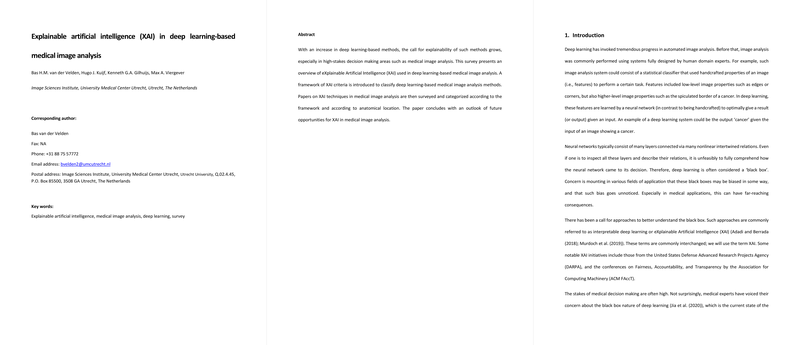Overview of eXplainable Artificial Intelligence in Deep Learning-based Medical Image Analysis
The surveyed paper presents a comprehensive examination of explainable artificial intelligence (XAI) as it applies to deep learning-driven medical image analysis. The authors, van der Velden et al., underscore the growing necessity for such explainability, particularly in settings where decision-making stakes are profoundly high, such as in medical diagnostics. The paper introduces a framework composed of three principal XAI criteria: model-based versus post hoc, model-specific versus model-agnostic, and global versus local explanations. This framework serves as a structural basis for categorizing surveyed studies.
Key Findings
- XAI Framework and Methodology:
- The framework delineates model-based explanations, rooted in interpretable models where explanations are inherent to the model, and post hoc explanations, which attempt to elucidate already trained models. It also distinguishes between model-specific methods, tailored to specific types of models e.g., CNNs, and model-agnostic approaches, applicable broadly regardless of model architecture.
- The taxonomy also distinguishes explanations based on scope: global explanations provide insight across datasets, while local explanations offer case-specific insights.
- Survey and Categorization:
- The survey includes 223 papers and categorizes them by anatomical region and imaging modality, revealing that most focus on chest and brain regions utilizing X-rays or MRIs.
- Techniques are primarily post hoc, model-specific, and local, aligning with trends seen in deep learning applications in clinical settings.
- Evaluation and Critiques:
- The paper reviews methodologies for XAI evaluation, including application-, human-, and functionally-grounded evaluations. It concurs with Doshi-Velez and Kim (2017), acknowledging the complexity and cost therein.
- Critique is mindful of concerns put forth by Rudin (2019) regarding the potential misalignment between model outputs and XAI explanations. Adebayo et al. (2018) provides insights into the robustness of saliency maps, introducing skepticism about specific visual explanation methods.
- Holistic Approaches and Future Directions:
- A trend toward integrating multiple forms of explanations, such as combining visual and textual cues, suggests a shift to more comprehensive pipelines.
- The authors propose future inquiries into biological explanations and causal reasoning in medical imaging as underpinning directions for augmenting rigor and reducing biases.
Implications and Future Prospects
The implications of integrating XAI into medical image analysis are manifold. Practically, there is a significant potential to improve clinician trust and decision-making processes by elucidating the rationale behind algorithm-driven results. This is critical for regulatory compliance, such as adherence to GDPR mandates for decision transparency. Theoretically, extending XAI to leverage causal models could help transcend beyond associative insights towards explicative, mechanistic understandings which are of keen interest when dealing with intricate physiological datasets.
In the scope of future AI developments, the systemic adoption of XAI principles could redefine normatives in AI-based diagnostics. Given the exponential growth of data and computational capabilities, the exploration of unsupervised, self-explanatory models, as well as guidelines for sample sizes, outlines crucial areas likely to be at the forefront of AI integration into medical practice.
Conclusion
This survey effectively encapsulates the burgeoning field of XAI in deep learning-led medical image analysis, highlighting current trends, methodological diversity, and critiques of existing practices. With the increasing convergence of AI and healthcare, especially in imaging, XAI stands as an essential component to ensure ethical, transparent, and effective deployment of advanced AI models in critical domains.
